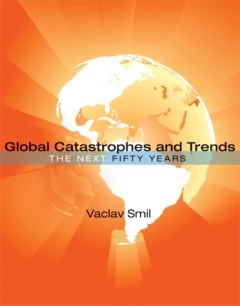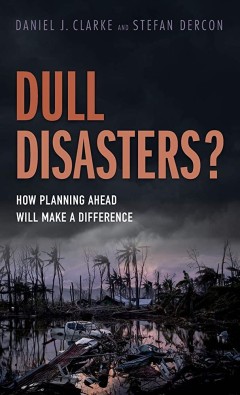Filter by

Advances in Assessment and Modeling of Earthquake Loss
This open access book originates from an international workshop organized by Turkish Natural Catastrophe Insurance Pool (TCIP) in November 2019 that gathered renown researchers from academia, representatives of leading international reinsurance and modeling companies as well as government agencies responsible of insurance pricing in Turkey. The book includes chapters related to post-earthquake …
- Edition
- -
- ISBN/ISSN
- 9783030688134
- Collation
- 308 hlm; ill., lamp.,
- Series Title
- -
- Call Number
- -
The Demography of Disasters
This open access book provides worldwide examples demonstrating the importance of the interplay between demography and disasters in regions and spatially. It marks an advance in practical and theoretical insights for understanding the role of demography in planning for and mitigating impacts from disasters in developed nations. Both slow onset (like the of loss polar ice from climate change)…
- Edition
- -
- ISBN/ISSN
- -
- Collation
- -
- Series Title
- -
- Call Number
- -

Global catastrophes and trends The Next Fifty Years
From the Publisher: Fundamental change occurs most often in one of two ways: as a "fatal discontinuity," a sudden catastrophic event that is potentially world changing, or as a persistent, gradual trend. Global catastrophes include volcanic eruptions, viral pandemics, wars, and large-scale terrorist attacks; trends are demographic, environmental, economic, and political shifts that unfold over …
- Edition
- -
- ISBN/ISSN
- -
- Collation
- 1 online resource (xi, 307 pages) : illustrations, maps
- Series Title
- -
- Call Number
- -

Global catastrophes and trends The Next Fifty Years
From the Publisher: Fundamental change occurs most often in one of two ways: as a "fatal discontinuity," a sudden catastrophic event that is potentially world changing, or as a persistent, gradual trend. Global catastrophes include volcanic eruptions, viral pandemics, wars, and large-scale terrorist attacks; trends are demographic, environmental, economic, and political shifts that unfold over …
- Edition
- -
- ISBN/ISSN
- -
- Collation
- 1 online resource (xi, 307 pages) : illustrations, maps
- Series Title
- -
- Call Number
- -

Catastrophes, confrontations, and constraints :how disasters shape the dynami…
A ground-breaking study on how natural disasters can escalate or defuse wars, insurgencies, and other strife. Armed conflict and disasters are two key challenges of the twenty-first century. The number of armed conflicts has never been higher since the end of World War II. At the same time, disasters have increased in frequency and intensity over the past two decades due to climate change, urba…
- Edition
- -
- ISBN/ISSN
- 9780262374507
- Collation
- 1 online resource (288 pages).
- Series Title
- -
- Call Number
- -

Nordenholt's million
Previously published, 1923."Bacteria inimical to plant growth spread around the world, causing a blight, Jack Flint is invited to become director of operations at Nordernholt's survivalist colony in England's Clyde Valley"--OCLC-licensed vendor bibliographic record.
- Edition
- -
- ISBN/ISSN
- 9780262371117
- Collation
- 1 online resource.
- Series Title
- -
- Call Number
- -

Disrupted economic relationships :disasters, sanctions, dissolutions
Empirical studies and theoretical analyses examine the causes and consequences of disruptions in cross-border economic relationships, including political conflict, economic sanctions, and institutional collapse. Cross-border economic relationships gradually strengthened in the decades after World War II; for most of the postwar period, international trade and investment have grown faster than o…
- Edition
- -
- ISBN/ISSN
- 9780262353083
- Collation
- 1 online resource (304 pages).
- Series Title
- -
- Call Number
- -

Global catastrophes and trends :the next 50 years
From the Publisher: Fundamental change occurs most often in one of two ways: as a "fatal discontinuity," a sudden catastrophic event that is potentially world changing, or as a persistent, gradual trend. Global catastrophes include volcanic eruptions, viral pandemics, wars, and large-scale terrorist attacks; trends are demographic, environmental, economic, and political shifts that unfold over …
- Edition
- -
- ISBN/ISSN
- 9780262283878
- Collation
- 1 online resource (xi, 307 pages) :illustrations, maps
- Series Title
- -
- Call Number
- -

Disaster Vulnerability, Hazards and Resilience Perspectives from Florida
This monograph provides valuable lessons in building disaster resilience for rural communities and beyond. With a focus on Florida, the authors present a comprehensive review of the current debates surrounding the study of resilience, from federal frameworks, state plans and local initiatives. They also review evaluation tools and feature first-hand accounts of county emergency managers as well…
- Edition
- -
- ISBN/ISSN
- 9783319164533
- Collation
- -
- Series Title
- -
- Call Number
- 303.485

Dull Disasters? How planning ahead will make a difference
Economic losses from disasters are now reaching an average of US$250–$300 billion a year. In the last 20 years, more than 530,000 people died as a direct result of extreme weather events; millions more were seriously injured. Most of the deaths and serious injuries were in developing countries. Meanwhile, highly infectious diseases will continue to emerge or re-emerge, and natural hazards wil…
- Edition
- -
- ISBN/ISSN
- -
- Collation
- -
- Series Title
- -
- Call Number
- 363.34 CLA d
 Computer Science, Information & General Works
Computer Science, Information & General Works  Philosophy & Psychology
Philosophy & Psychology  Religion
Religion  Social Sciences
Social Sciences  Language
Language  Pure Science
Pure Science  Applied Sciences
Applied Sciences  Art & Recreation
Art & Recreation  Literature
Literature  History & Geography
History & Geography